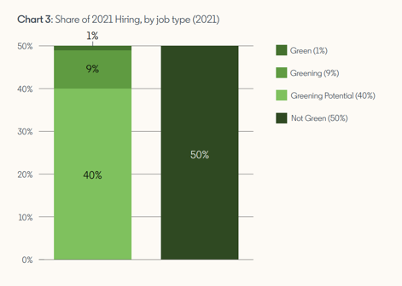Green Skills are those that enable the environmental sustainability of economic activities (source = Linkedin report).
The surge in demand for these skills signals a transformative shift in our professional landscape. The evolving needs of the green transition require a fresh perspective on talent acquisition. According to the LinkedIn Green Report,
- European job postings seeking green skills have grown by 8% annually over the past five years, outpacing the 6% annual growth of the green talent pool.
- Also, a lot of room to up-skill existing jobs. These are called “greening potential” jobs and account for 40% of global workforce (see picture below)
As we anticipate an imminent shortage in green skills, how can companies proactively bridge this gap?
Here’s a strategic roadmap:
1. Assess Your Situation and Develop a Sustainable Strategy:
Conduct a comprehensive analysis of your current situation, including a detailed examination of your CO2 footprint . This will unveil your unique priorities for action.
For instance, a CO2 footprint study might reveal that a significant portion of emissions stems from suppliers. In this case, prioritizing the development the procurement team could be more impactful than focusing solely on interal operations.
Need help with CO2 Footprint assessment. Get in touch with our team.
2. Understand What Skills are Missing:
Identify the specific green skills lacking in your workforce. This understanding is crucial for targeted skill development and recruitment efforts.
Utilize available resources, like the LinkedIn Green Report 2023, to gain insights into emerging green skills trends.

Source: Linkedin Green report
3. Choose In-House vs Outsource:
Consider the balance between leveraging internal champions and hiring external consultants. An internal champion brings knowledge of your organizational culture, business intricacies, technologies, and processes.
On the other hand, hiring an externally trained consultant can expedite the process and potentially save costs. The decision should hinge on the effort required and the strategic importance of the green transition within your organization.
In the race to bridge the green skills gap, companies must adopt a proactive and strategic approach. By aligning priorities, understanding missing skills, and making informed decisions on in-house versus outsourcing, businesses can pave the way for a successful and sustainable green transition.

